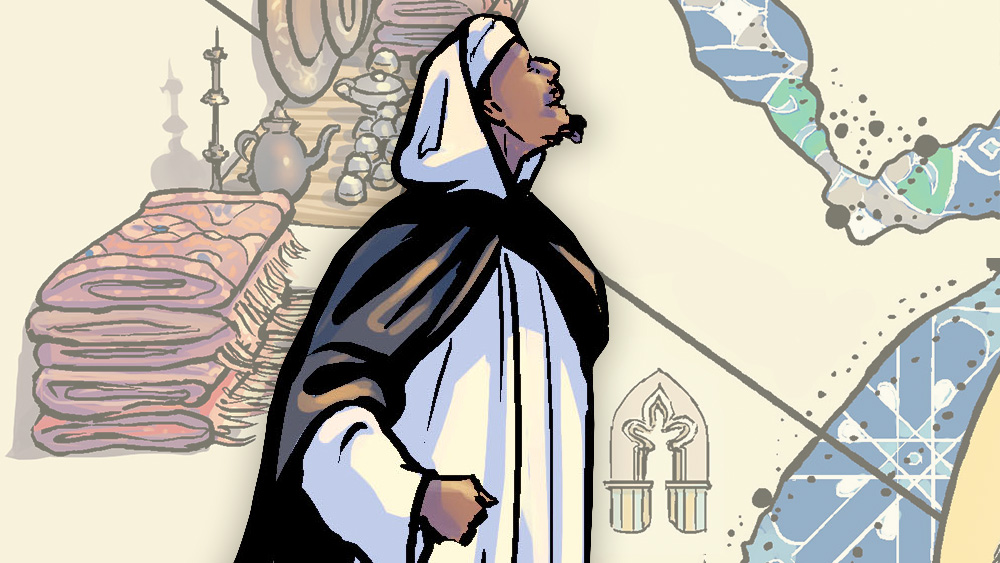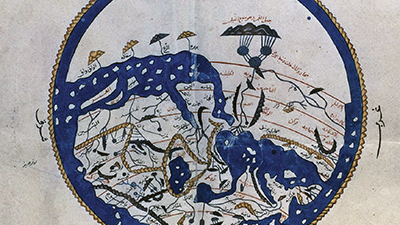Developments in Dar al-Islam
Teacher Resources
Driving Question: How did the expansion of Dar al-Islam shape political systems, cultural exchanges, and technological advancements?
Dar al-Islam, a term that translates to “World of Islam” or “Abode of Islam”, describes much more than a geographic region in which Islam held influence. Stretching from North Africa, through the Middle East, all the way out to the East Indies, Dar al-Islam encompasses a vast array of cultures, languages, and traditions, all intertwined by their shared belief in Islam.
Learning Objectives:
- Explain how systems of belief and their practices affected various societies in the period from c. 1200 to c. 1450.
- Explain the causes and effects of the rise of different Islamic states over time.
- Explain the effects of intellectual innovation in Dar al-Islam.
- Learn about strategies to help you respond to short-answer questions (SAQs) on the AP® World History exam.
Vocab Terms:
- caliphate
- Christianity
- dynasty
- Islam
- Judaism
- polytheistic
Opener: Developments in Dar al-Islam
To teach this lesson step, refer to page 2 of Lesson 1.2 Teaching Guide.
What do you think the defining characteristics of belief systems are? Connect these with what you have learned and with the frame narratives.
The Emergence of Islam
To teach this lesson step, refer to page 3 of Lesson 1.2 Teaching Guide.
Check out this thread on making video lessons more exciting, for some ideas and inspiration.
Islam is one of the world’s largest religions. Almost a quarter of the world’s population identifies as Muslim. How did Islam grow to become one of the world’s biggest religions?
-
Guiding Questions
-
Before you watch
Preview the questions below, and then review the transcript.
While you watch
Look for answers to these questions:
- According to the Islamic faith, who received messages from God?
- What are the Five Pillars of Islam?
- What are Hadith?
- How far did Islam expand in the first century after the death of the Prophet? How was this expansion achieved?
- How did Islam spread from 750 to 1700?
- What do most historians agree on about early Islam?
- What are the important sources of Islamic history for Muslims?
After you watch
Respond to the following questions:
- To what extent does this video help explain how belief systems impacted society from c. 1200 to 1450?
- Why do you think understanding Islamic history is important for practicing Muslims? In what aspects of your life is understanding history important for your own activities?
- In this video, Nate Bowling talked about different narratives about Islam that may be politically motivated. Can you think of a politically-motivated narrative about a religion that you have heard? Do you think this narrative is credible? Why or why not?
Key Ideas
Dar-al-Islam 1200–1450
To teach this lesson step, refer to page 4 of Lesson 1.2 Teaching Guide.
Check out this recorded PD session about the story of knowledge and scholars from the Islamic world.
Empires come and go, but belief systems can last much longer. This is most certainly the case with Islam, one of the largest and oldest belief systems in the world.
-
Guiding Questions
-
Before you read
Preview the questions below, and then skim the comic, paying attention to things like prominent colors, shapes, and types of text and fonts. How do you know where to start and in which direction to read? What’s in the gutters (the space between panels)? Who or what is the focus of the comic?
While you read
- Who was Ibn Battuta and why did he leave his home?
- How was Ibn Battuta able to support himself while he traveled?
- What do the quotes from Ibn Battuta’s writing tell you about his experiences while traveling?
- What does the story about Ibn Battua’s interactions with Al-Bushri tell you about the nature of Dar al-Islam during this period?
- How does the artist use art and design to demonstrate Islamic cultural connections during this period?
After you read
Respond to this question: How does this graphic biography of Ibn Battuta support, extend, or challenge what you have learned about the Islamic world?
-
Guiding Questions
-
Before you read
Preview the questions below, and then skim the article. Be sure to look at the section headings and any images.
While you read
Look for answers to these questions:
- What is Dar al-Islam?
- What were some of the cultural and technological innovations of Islamic scholars during this period?
- What were the effects of these innovations in Dar al-Islam?
- The author argues that Islam experienced a political fragmentation while it also saw a cultural expansion. What does he mean?
- What does Ibn Battuta’s experience on his travels have to tell us about Dar al-Islam?
After you read
Respond to the following questions:
- To what extent does this article explain how systems of belief and their practices affected societies from c. 1200 to 1450?
- This article emphasizes the theme of cultural developments and interactions as well as governance. The author claims that even though the political structure of Dar al-Islam fractured at this time, the religious community expanded and united many people. What evidence does the author give for his claim and do you agree with it? Is there another theme that could be used to examine the changes that occurred in Dar al-Islam at this time?
- Does it make sense for historians to define a region based on a shared belief system, rather than a single government? Why or why not?
Causes and Consequences of the Crusades
To teach this lesson step, refer to page 5 of Lesson 1.2 Teaching Guide.
How did centuries-long wars between Christians and Muslims lead to productive cultural and scientific exchanges? It doesn’t seem like war would be great for intellectual exchange, but stranger things have happened!
-
Guiding Questions
-
Before you watch
Preview the questions below, and then review the transcript.
While you watch
Look for answers to these questions:
- Why did the Byzantine Emperor reach out to the pope for help? Why did the pope agree?
- Were the Crusades successful and how did they impact networks in the Mediterranean world?
- Which European powers benefited the most from the Crusades?
- What evidence do we have that the Crusades impacted both Christian and Islamic culture?
- How did the Crusades affect scholarship in Europe?
- How did this period of exchange lead to the Renaissance and Columbian Exchange?
After you watch
Respond to the following question:
- How does this video change your thinking about the concept of a European “Dark Age”?
Key Ideas
Conflict vs. Connection
Conflict and connections. It sounds like a board game, but it’s also a great way to describe history.
Closer: Developments in Dar al-Islam
To teach this lesson step, refer to page 6 of Lesson 1.2 Teaching Guide.
Our Writing Guide shares our approach to informal and formal writing, including SAQs.
You will be an ACE at answering the SAQ portion of the AP® World History: Modern exam if you remember to Answer, Cite, and Explain!






